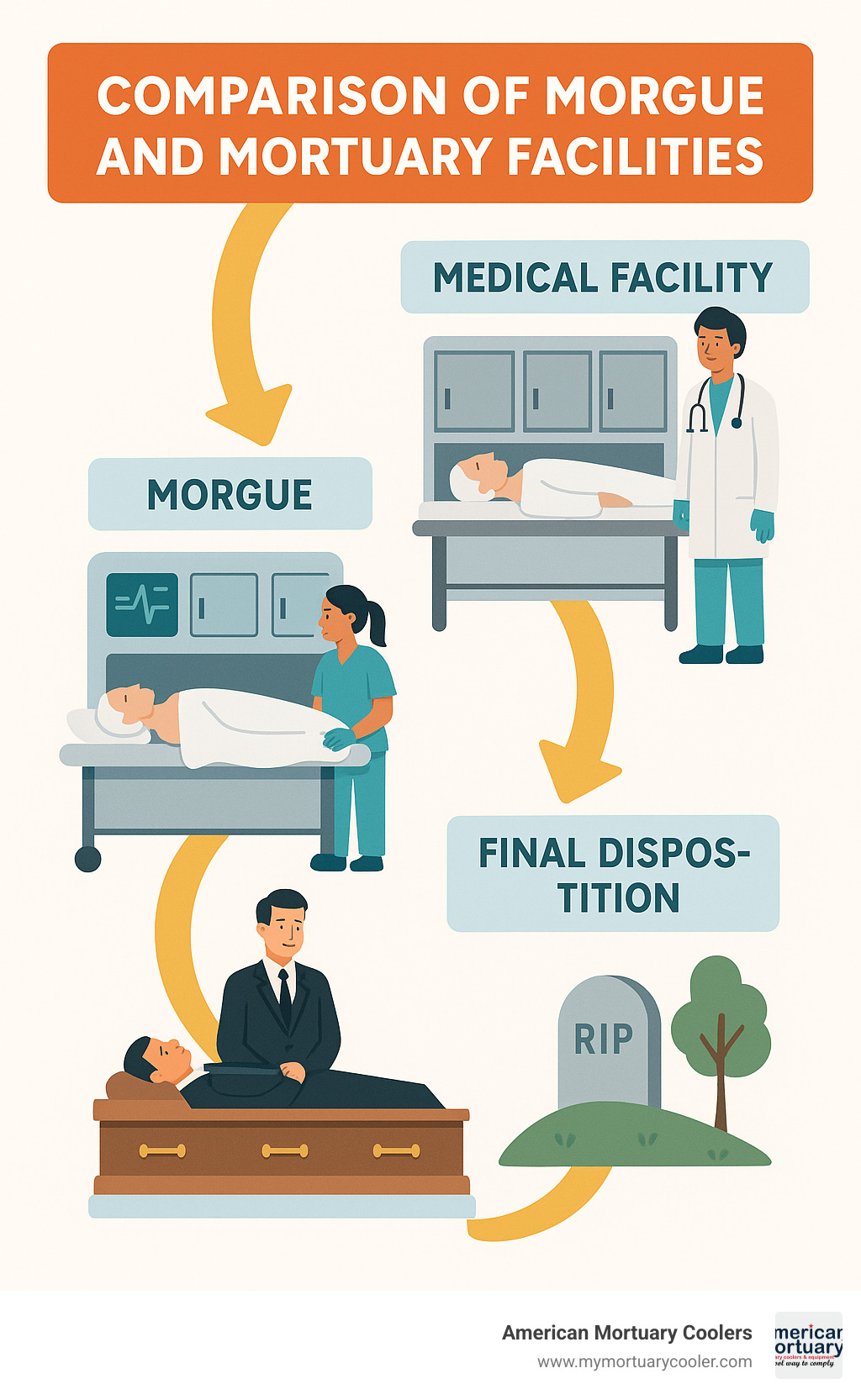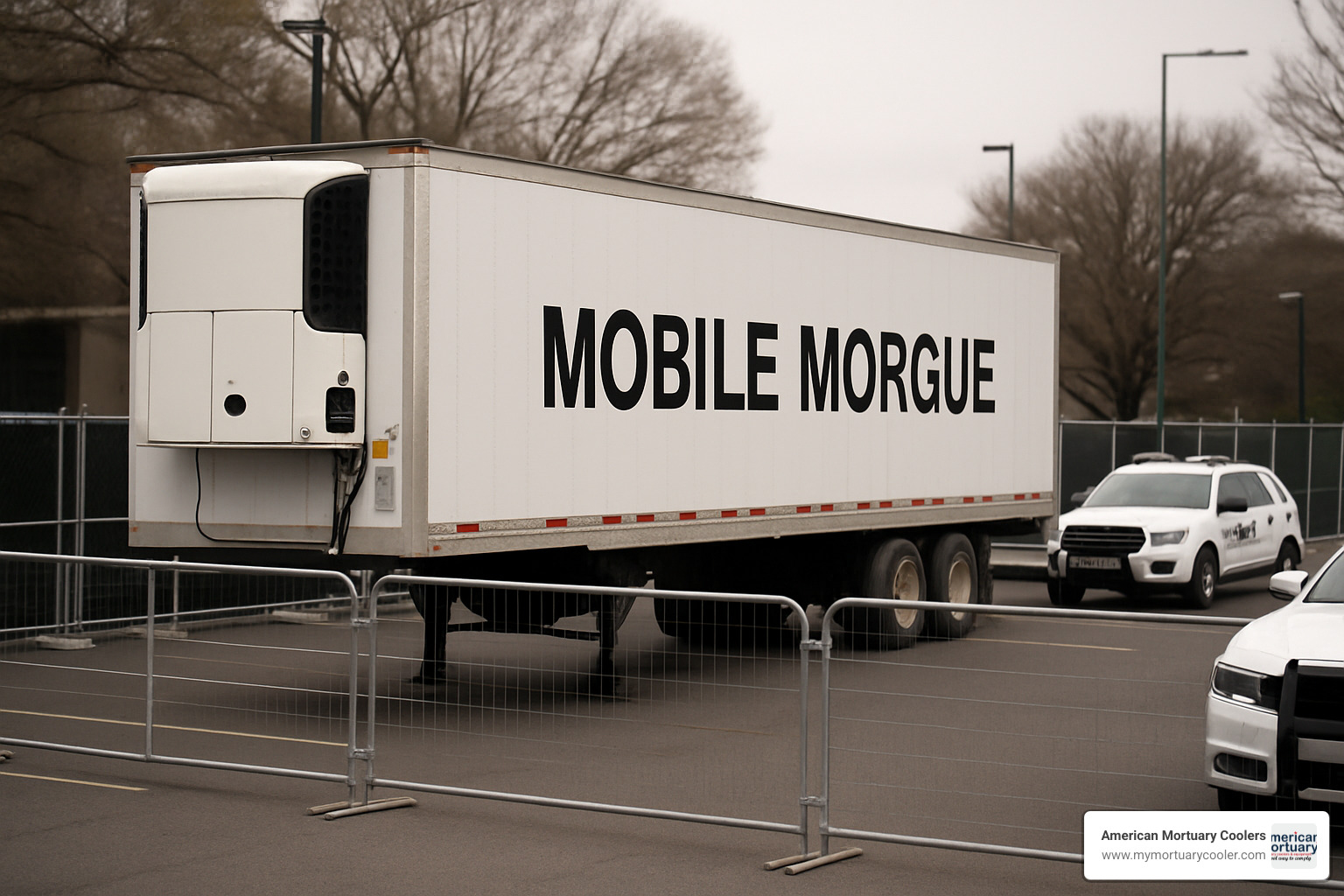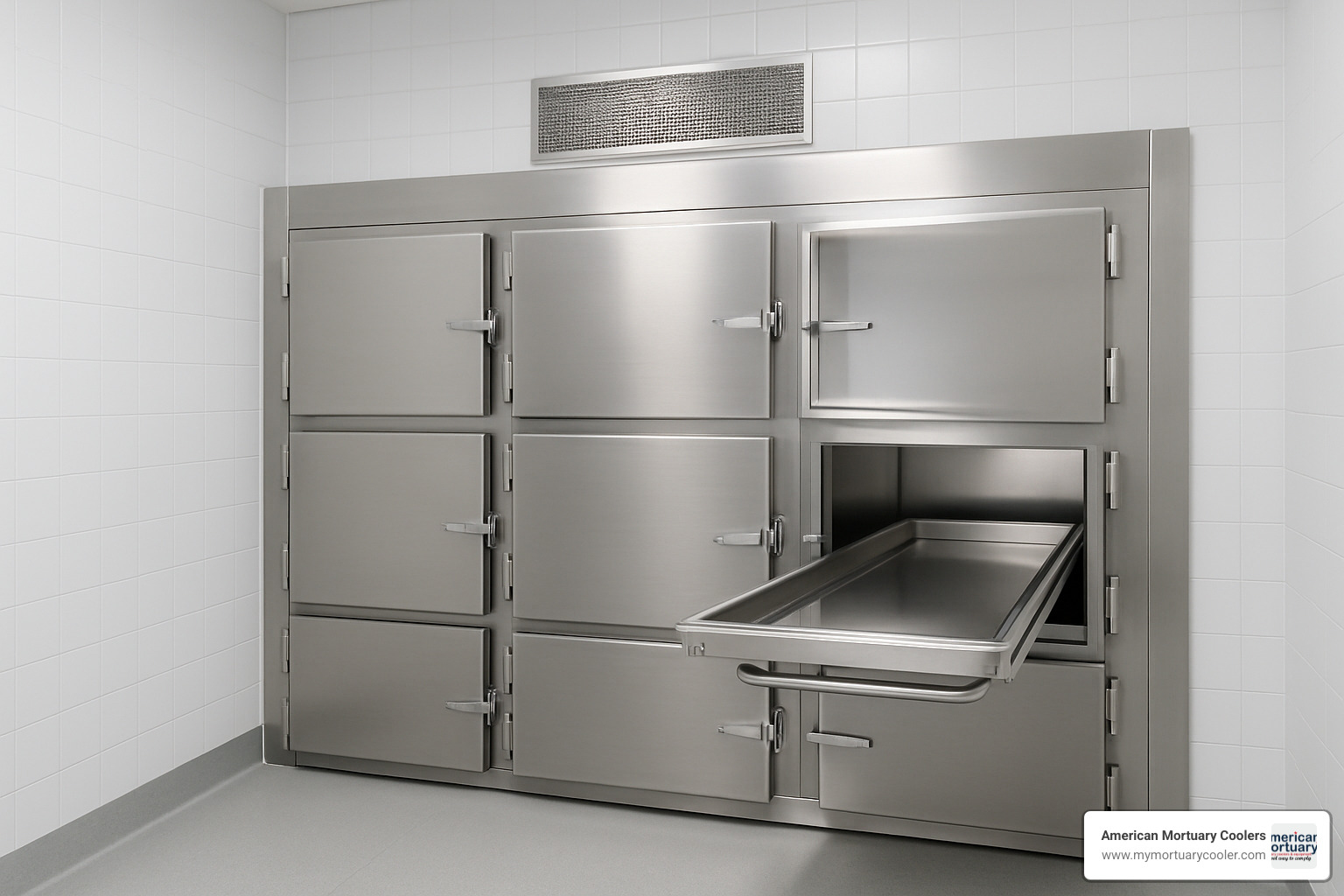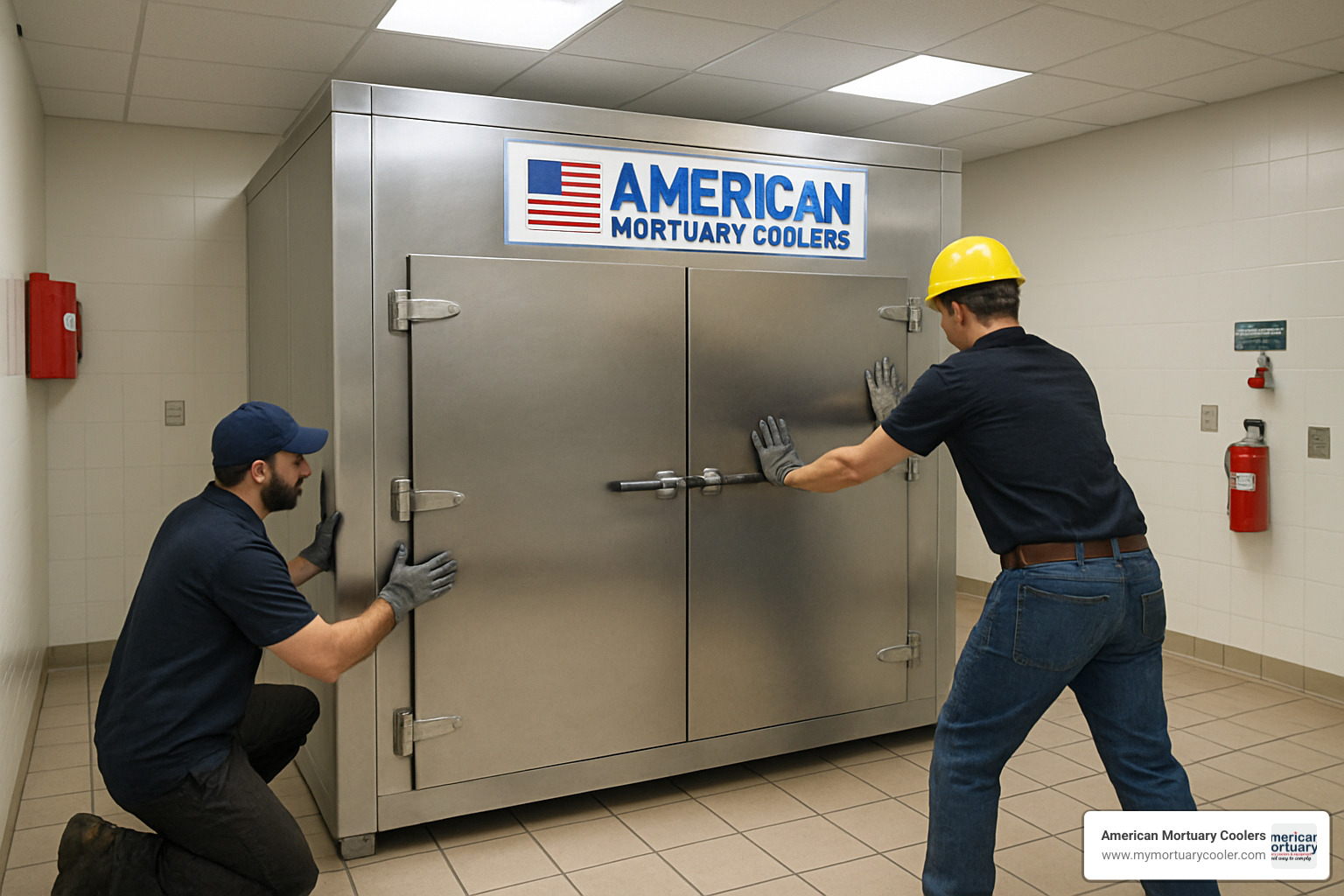Understanding the Difference Between Mortuaries and Morgues
Mortuary and morgue facilities serve important roles in end-of-life care, with distinct functions and purposes. Here's a quick comparison:
| Facility | Primary Purpose | Location | Who Works There | Services Offered |
|---|---|---|---|---|
| Morgue | Temporary storage and forensic examination | Hospitals, medical centers, coroner's offices | Medical examiners, forensic pathologists, morgue technicians | Body storage (35-40°F), autopsies, identification |
| Mortuary | Body preparation and funeral services | Funeral homes, standalone facilities | Morticians, embalmers, funeral directors | Embalming, cosmetic preparation, cremation, burial arrangements |
A morgue primarily serves as a secure, refrigerated facility for temporary storage of deceased individuals until they can be identified, examined, or claimed by family members. Bodies are typically kept at temperatures between 35-40°F (2-4°C) to slow decomposition.
In contrast, a mortuary focuses on preparing the deceased for final disposition through services like embalming, dressing, and cosmetic preparation. Many mortuaries are attached to funeral homes and offer comprehensive services including cremation, burial arrangements, and memorial planning.
While some facilities may function as both a morgue and a mortuary, they serve different stages in the post-death process. Morgues handle the initial, often clinical phase, while mortuaries manage the ceremonial and final preparation phase.

Mortuary and morgue helpful reading:
The History & Purpose of Morgues
The word "morgue" traces back to 1880s Paris, where it described a place where unidentified bodies were displayed for identification. Today, the term has evolved significantly.
Morgues serve as essential facilities in our medical and legal systems. These specialized spaces provide the controlled environment necessary for medical examiners and forensic pathologists to investigate deaths that require further examination. Standard morgues maintain temperatures between 2-4°C (35-39°F), slowing decomposition while allowing for thorough examination.
For cases requiring longer-term storage, specialized negative-temperature chambers operate between -10°C to -50°C (-14°F to -58°F), particularly important in forensic institutes where investigations might extend over time.
You'll typically find morgues and mortuaries in several key locations: within hospitals, coroner's offices, medical examiner facilities, and forensic institutes. America's first official morgue opened in 1866 at New York's Bellevue Hospital, establishing a model that spread throughout the country.
These facilities rely on specialized professionals:
- Medical examiners and forensic pathologists who perform detailed autopsies
- Morgue technicians who prepare bodies and assist with examinations
- Forensic investigators who document findings and collect evidence
Forensic Services Inside a Morgue
Inside a working morgue, science serves truth. The primary services provided are critical to both medical understanding and our justice system:
Autopsies form the cornerstone of forensic investigation. Forensic pathologists examine the body both externally and internally, documenting findings that might explain how and why the person died.
Identification services employ multiple techniques when identity is uncertain, including fingerprinting, dental record comparison, DNA analysis, or family confirmation when appropriate.
Toxicology plays a vital role in many investigations, with samples of bodily fluids and tissues analyzed for substances that might have contributed to death.
The workflow in a morgue follows careful protocols:
- Receipt and documentation of the body
- Initial examination with photography
- Secure refrigerated storage
- Forensic examination or autopsy when required
- Collection of samples for laboratory testing
- Preparation of detailed reports
- Release of the body to family or funeral home
Temporary vs. Emergency Morgues
Natural disasters, pandemics, or mass casualty events can overwhelm standard morgue facilities, requiring flexible solutions.

Mobile Morgue Trailers represent modern innovation in emergency response. These specialized 53-foot refrigerated trailers can be rapidly deployed wherever needed, equipped with body racks and basic examination equipment.
Repurposed Facilities sometimes offer unexpected solutions. During COVID-19, ice skating rinks in several countries temporarily served as emergency morgues, utilizing their existing refrigeration systems and spacious layouts.
Waiting Mortuaries offer a fascinating historical perspective. These 19th-century facilities, particularly popular in Germany, addressed the fear of premature burial. Bodies would rest with bells attached to their hands or feet that would ring if movement occurred.
Mass-Fatality Planning has become standard practice in modern emergency management, with detailed plans for deploying refrigerated trucks, portable cooling units, and other resources when disaster strikes.
Inside Modern Mortuaries
Modern mortuaries are designed with both functionality and dignity in mind. Unlike the clinical environment of a morgue, mortuaries are warm, respectful places where loved ones are prepared for their final farewell.
These facilities feature stainless steel preparation tables with integrated water and drainage systems, specialized lighting for detailed cosmetic work, and dedicated areas for different aspects of care.
Embalming remains a cornerstone service in many mortuaries. This process involves carefully injecting preservative chemicals into the body's vascular system, creating a peaceful, natural appearance for open-casket viewings.
The cosmetic preparation that happens in mortuaries is truly an art form. Skilled professionals restore a natural appearance, apply makeup with a delicate touch, style hair, and dress the deceased in clothing chosen by the family.

Many modern mortuaries now offer on-site cremation services, eliminating the need for additional transport and allowing for more seamless care.
The heart of any mortuary is its people. Funeral directors wear many hats – they're technical professionals, compassionate guides, and steady presences for families navigating grief.
Core Mortuary Services
The services provided in a mortuary encompass all aspects of preparing someone for their final disposition.
Every preparation begins with gentle washing and disinfection – a first step that ensures sanitary conditions. This initial care is performed with respect and attention to detail.
While not always required by law, embalming remains common practice when families choose open-casket viewings or when burial will be delayed. Different regions have specific requirements – in New South Wales, Australia, for example, full embalming is mandated when a body is being transported overseas, placed in above-ground vaults, kept unrefrigerated for more than eight hours, or stored longer than five days.
The dressing and cosmetic preparation phase is deeply personal. Mortuary staff carefully dress the deceased in clothing provided by the family and apply cosmetics to create a natural, peaceful appearance.
Casketing involves placing the prepared body into the selected casket or container with care and attention.
Many families today choose direct cremation, and mortuaries have adapted to offer these simplified services without embalming or viewing.
Mortuary Equipment & Coolers
The equipment in modern mortuaries blends function with compassion, designed for efficiency and hygiene while ensuring dignified handling.
Preparation tables form the foundation of the mortuary workspace. Crafted from high-grade stainless steel with built-in drainage systems, these tables often feature adjustable heights for comfortable working conditions.
Proper ventilation systems are crucial in mortuary settings. Beyond controlling odors, these systems remove potentially harmful chemicals used in embalming.
The embalming equipment found in mortuaries has evolved significantly over time. Today's arterial injection machines, aspiration devices, and specialized instruments are designed for precision and effectiveness.
Perhaps most essential in any mortuary are the mortuary coolers – refrigeration units that maintain bodies at temperatures between 2-4°C (35-39°F). These units range from individual body boxes to walk-in coolers capable of caring for multiple individuals.
Mortuary and Morgue: Side-by-Side Comparison
Understanding the difference between mortuary and morgue facilities can provide clarity during a difficult time. Let's look at how these two essential services compare:
| Feature | Morgue | Mortuary |
|---|---|---|
| Primary Function | Temporary storage and forensic examination | Preparation for burial or cremation |
| Typical Location | Hospitals, medical examiner offices | Funeral homes, standalone facilities |
| Staff | Medical examiners, forensic pathologists, morgue technicians | Morticians, embalmers, funeral directors |
| Temperature Range | 2-4°C for standard storage; -10 to -50°C for forensic preservation | 2-4°C for refrigerated storage |
| Services Offered | Autopsies, identification, evidence collection | Embalming, cosmetic preparation, dressing, casketing |
| Family Interaction | Limited; typically only for identification | Extensive; consultation, viewing, services |
| Average Stay Duration | Days to weeks; months for unidentified remains | 1-3 days for preparation before services |
| Regulatory Oversight | Medical/forensic authorities, coroners | Funeral service boards, health departments |
| Cost to Families | Usually no direct cost (covered by public funds) | $1,000-$4,000+ depending on services |
| Atmosphere | Clinical, utilitarian | Somber, dignified, often homelike |
This comparison highlights the complementary roles these facilities play in caring for the deceased. While morgues handle the medical, legal, and investigative aspects, mortuaries address the ceremonial, emotional, and cultural dimensions of death care.

Why Understanding a Mortuary and Morgue Matters
Knowing the difference between a mortuary and morgue isn't just about terminology – it makes a real difference for families navigating the challenging days after losing someone they love.
For families, this understanding provides peace of mind about where their loved one is being cared for. It helps them make clearer decisions during an emotionally overwhelming time and gives them realistic expectations about timing and next steps.
For professionals in death care, clear communication about these distinctions helps coordinate the transition between medical facilities and funeral service providers.
This knowledge is especially important for honoring cultural and religious practices. Many traditions have specific timeframes for burial or cremation – some requiring the process to be completed within 24 to 72 hours.
Common Misconceptions About a Mortuary and Morgue
Television shows and movies have given us some pretty wild ideas about what goes on in mortuary and morgue facilities. Let's clear up some of these misunderstandings:
Modern morgues are actually well-lit, clinical environments. Bodies are stored respectfully in refrigerated compartments, not displayed dramatically as TV would have you believe.
Many people use the terms "mortuary" and "funeral home" interchangeably, but they're not quite the same thing. While many funeral homes contain mortuaries, the mortuary specifically refers to the preparation facility.
Contrary to popular belief, not everyone goes to a morgue after death. Only bodies requiring autopsy, formal identification, or those involved in criminal investigations typically go to morgues.
Mortuaries don't perform autopsies – that's a morgue function. Autopsies are conducted by medical examiners or forensic pathologists, not by mortuary staff.
Many people believe embalming is legally required for all deceased persons, but this simply isn't true. Embalming is rarely mandated by law except in specific circumstances such as interstate transport or when there will be extended delays before burial.
Legal, Cultural & Cost Considerations
When it comes to mortuary and morgue facilities, legal rules, cultural practices, and financial factors shape how they operate. These considerations vary widely depending on location and continue to evolve.
The legal landscape differs significantly - morgues typically answer to medical examiners, coroners, or public health departments, while mortuaries must comply with funeral service boards and state licensing agencies. Colorado's House Bill 24-1335, which became law in 2024, will strengthen oversight of mortuary professionals by January 2027.
For autopsies, medical examiners generally have authority to perform them in cases involving suspicious deaths, sudden deaths without clear causes, deaths in custody, or public health concerns. Many states recognize religious objections to autopsy, making accommodations when possible.
Embalming isn't usually required by law. It's only mandated in specific situations like transporting remains across state lines, when burial will be delayed, or for public viewings in some places.
Cultural and religious traditions play a huge role in how quickly bodies move through facilities. Many faiths have specific timeframes for burial - Islamic and Jewish traditions typically call for burial within 24 hours, while many cultures observe a three-day window.
Regarding costs, morgue services are typically covered by public funding with no direct charges to families. Mortuary services, however, do come with costs:
- Basic preparation services: $600-$1,200
- Embalming: $500-$1,000
- Cosmetic preparation: $200-$400
- Viewing arrangements: $400-$600
- Cremation services: $800-$3,000
- Full-service burial preparation: $2,000-$4,000+
Overlapping Facilities & Hybrid Models
The line between mortuary and morgue facilities isn't always clear-cut. Many institutions have developed hybrid models that combine elements of both.
Many larger hospitals maintain not just traditional morgue spaces but also mortuary areas where basic preparation can take place before transferring to funeral homes.
In rural areas and smaller communities, funeral homes often step up to fulfill morgue-like functions by enhancing their refrigeration capabilities. These funeral homes may have arrangements with local authorities to provide temporary storage for cases that would typically go to a county morgue.
Modern forensic centers have evolved too, often including areas for basic preparation following autopsy. These transitional spaces bridge the gap between the clinical morgue environment and the more ceremonial mortuary setting.
Resource-sharing has become increasingly common, especially in smaller communities where a hospital might maintain refrigeration facilities that serve not only its needs but also those of local funeral homes or the county coroner.
Mortuary vs Funeral Home vs Crematorium
The terminology in death care facilities can be confusing. Terms like mortuary, funeral home, and crematorium serve different—though sometimes overlapping—purposes.
A mortuary focuses primarily on the technical aspects of preparing the deceased. The emphasis is on embalming, washing, dressing, and cosmetic services. Mortuaries may stand alone or be part of a larger funeral home.
A funeral home offers comprehensive services that include both preparation and ceremonial aspects. These facilities include viewing rooms, chapels, and consultation spaces where families can make arrangements.
A crematorium specializes in cremation services with specialized equipment called retorts. These facilities may stand alone or be part of a funeral home and can range from offering basic direct-cremation services to comprehensive ceremonial options.
What Happens to a Body Step-by-Step
When someone passes away, their body begins a carefully managed journey through various facilities. Understanding this process can bring clarity during a difficult time.
Death begins with an official pronouncement by a qualified medical professional. Once death is confirmed, the next steps depend largely on the circumstances.
For hospital deaths, staff will move the body to the hospital mortuary and morgue facility. If someone passes at home, either a funeral home or medical examiner will arrange transportation. In cases where death is unexpected or suspicious, the medical examiner's office takes immediate custody.
If the body goes to a morgue, several important steps happen:
The staff carefully tags the body and enters information into their tracking systems. They'll also inventory and secure any personal belongings. The body is then placed in refrigerated storage at 35-40°F (2-4°C) to preserve it with dignity.
In some cases, an autopsy might be necessary to determine the cause of death. The medical examiner might also collect samples for toxicology testing if required.
Once any necessary examinations are complete, the body is released to the funeral home chosen by the family. This transfer requires proper documentation, including a death certificate and transport permits.
When your loved one arrives at the mortuary, staff will verify their identity and confirm your family's wishes regarding preparation. Until preparations begin, they'll place the body in refrigerated storage.
The mortuary and morgue preparation process includes gentle washing and disinfection, embalming if requested, dressing in provided clothing, hair styling and makeup, and placement in the selected casket or container.
The final phase involves the disposition you've chosen – perhaps a viewing or visitation, followed by a funeral or memorial service, and ultimately burial, cremation, or an alternative option.
Family Interaction Points
Throughout this journey, families connect with their loved one and the process at several key moments. These touchpoints significantly shape both the experience and the grieving process.
When identification is necessary, family members may visit their loved one at a hospital morgue, medical examiner's facility, or funeral home. Modern mortuary and morgue facilities work hard to make this difficult experience as gentle as possible, with private viewing rooms separated from clinical areas.
After identification, you'll need to make several important decisions with the guidance of funeral professionals. You'll select a funeral home, choose between burial, cremation or other options, determine what level of preparation you want, and decide on the timing of services.
If your family chooses to have a viewing or visitation, you'll work closely with the funeral home to create a meaningful goodbye. You'll discuss clothing preferences, jewelry, and any personal items you'd like included.
There are also practical matters to address during this difficult time. You'll need to provide information for the death certificate, make payment arrangements, file any applicable insurance claims, and perhaps select cemetery property.
Frequently Asked Questions About Mortuaries and Morgues
When should someone use a morgue instead of a mortuary?
A morgue is the right place when the circumstances surrounding a death require additional steps before funeral arrangements begin. This includes situations where medical examiners need to investigate unexpected deaths, when an autopsy is necessary, or when someone passes away without immediate identification.
Hospitals also use morgues for temporary storage when someone dies in their care, giving families breathing room to select a funeral home without rushing decisions during an emotional time.
Mortuaries enter the picture when families are ready to move forward with funeral arrangements. Once any required investigations are complete and the body has been released, the mortuary handles preparation for viewing, embalming if desired, and the final steps toward burial or cremation.
Most families don't actually choose between them—the circumstances of death usually determine this path. But understanding the difference helps you know who to call when you need information about your loved one.
Who works in each facility and what are their qualifications?
In morgue settings, you'll typically find:
Medical Examiners and Forensic Pathologists are physicians who've completed medical school followed by extensive specialized training—usually 3-4 years in anatomic pathology plus an additional 1-2 years focusing specifically on forensic pathology.
Morgue Technicians assist with examinations and handle many practical aspects of body care. Most have backgrounds in biology or forensic science, with specific training in anatomy and evidence collection procedures.
Forensic Investigators document death scenes and gather evidence. Many come from law enforcement or criminal justice backgrounds, bringing investigative skills to this sensitive work.
In mortuary settings, you'll meet:
Embalmers are licensed professionals who've completed accredited mortuary science programs, served 1-2 year apprenticeships, and passed both state and national board examinations.
Funeral Directors guide families through the entire arrangement process with training that extends beyond technical skills to include grief counseling, business management, and understanding of diverse cultural traditions.
Can one building function as both a mortuary and a morgue?
Yes, one building can serve both mortuary and morgue functions—in fact, it happens more often than most people realize. These hybrid facilities have become increasingly common.
In larger hospitals, you'll often find both a clinical morgue area for temporary storage and autopsies, alongside a basic preparation area where some mortuary services can be performed before transfer to a funeral home.
Modern medical examiner facilities frequently take this hybrid approach even further. They'll house forensic examination areas for their morgue functions, preparation rooms for basic mortuary services, and comfortable viewing rooms designed specifically for family identification.
This combined approach becomes especially important in rural and small communities, where resources may be limited. In these areas, the local funeral home might actually serve dual roles through government contracts, providing both morgue services for the county and their standard mortuary functions for families.
Conclusion
Understanding the distinct yet complementary roles of mortuary and morgue facilities provides clarity during one of life's most challenging transitions. While morgues serve the clinical and investigative needs following death, mortuaries address the ceremonial and emotional aspects of saying goodbye.
These facilities differ in meaningful ways - from their primary functions and the professionals who staff them, to how families interact with each facility and the unique equipment each requires. Yet beneath these differences lies a shared commitment: providing dignified care for those who have passed and compassionate support for those left behind.

Our precision-engineered coolers are built to last, with durability that stands up to demanding environments. We deliver directly to your doorstep, whether you're in a busy city like Chicago or Atlanta, or serving a smaller community anywhere in the continental United States.
Families rarely choose directly between a morgue and mortuary—this path is usually determined by the circumstances of death and subsequent choices about final arrangements. However, understanding the distinct roles these facilities play helps families steer this difficult journey with greater confidence.
For professionals looking to upgrade your refrigeration systems, we invite you to explore our solutions at Your one-stop shop for mortuary coolers. Our team partners with you to find the perfect cooling solution for your specific needs, ensuring optimal performance for years to come.
Both mortuary and morgue facilities play essential, interconnected roles in the circle of life and death. When these institutions work together seamlessly, they create a path that honors the deceased while supporting those who mourn.


















